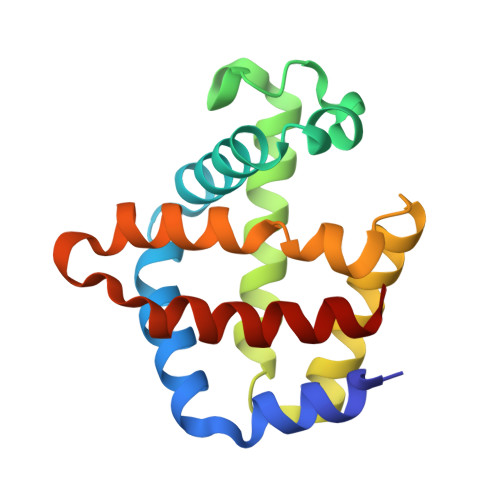Tertiary and Quaternary Allostery in Tetrameric Hemoglobin from Scapharca inaequivalvis.
Ronda, L., Bettati, S., Henry, E.R., Kashav, T., Sanders, J.M., Royer, W.E., Mozzarelli, A.(2013) Biochemistry 52: 2108-2117
- PubMed: 23458680
- DOI: https://doi.org/10.1021/bi301620x
- Primary Citation of Related Structures:
4HRR, 4HRT - PubMed Abstract:
The clam Scapharca inaequivalvis possesses two cooperative oxygen binding hemoglobins in its red cells: a homodimeric HbI and a heterotetrameric A2B2 HbII. Each AB dimeric half of HbII is assembled in a manner very similar to that of the well-studied HbI. This study presents crystal structures of HbII along with oxygen binding data both in the crystalline state and in wet nanoporous silica gels. Despite very similar ligand-linked structural transitions observed in HbI and HbII crystals, HbII in the crystal or encapsulated in silica gels apparently exhibits minimal cooperativity in oxygen binding, in contrast with the full cooperativity exhibited by HbI crystals. However, oxygen binding curves in the crystal indicate the presence of a significant functional inequivalence of A and B chains. When this inequivalence is taken into account, both crystal and R state gel functional data are consistent with the conservation of a tertiary contribution to cooperative oxygen binding, quantitatively similar to that measured for HbI, and are in keeping with the structural information. Furthermore, our results indicate that to fully express cooperative ligand binding, HbII requires quaternary transitions hampered by crystal lattice and gel encapsulation, revealing greater complexity in cooperative function than the direct communication across a dimeric interface observed in HbI.
Organizational Affiliation:
Department of Pharmacy, University of Parma , Parco Area delle Scienze, 23/A, 43124 Parma, Italy.

















